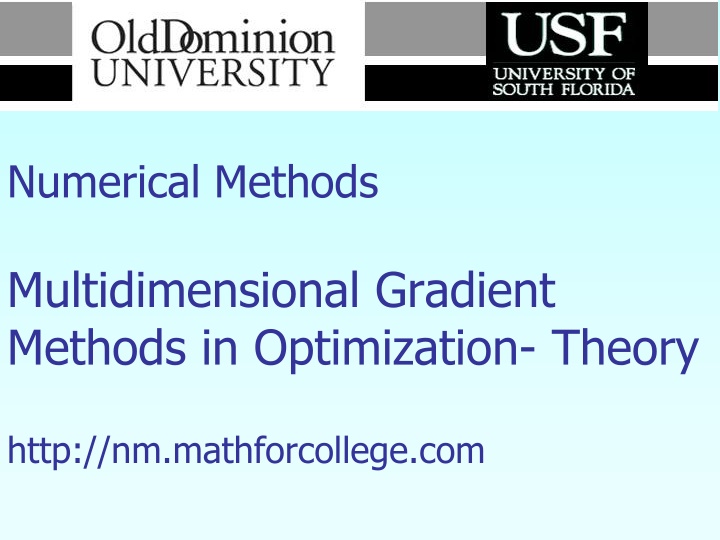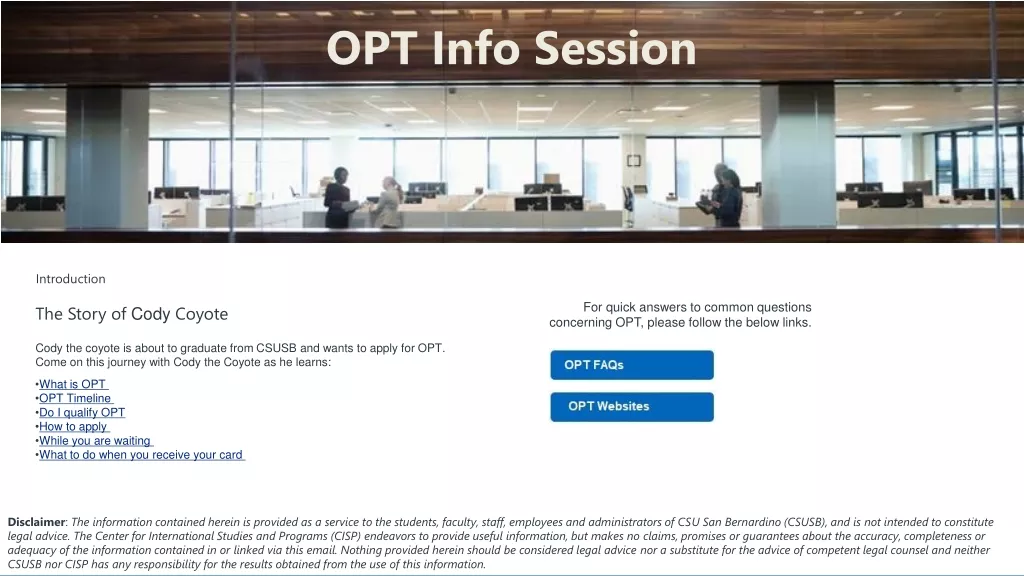
Multidimensional Gradient Methods in Optimization Theory Overview
Explore the use of multidimensional gradient methods in optimization theory to find solutions efficiently by leveraging derivatives of the objective function. Learn about gradients and Hessians to guide the search process effectively.
Download Presentation

Please find below an Image/Link to download the presentation.
The content on the website is provided AS IS for your information and personal use only. It may not be sold, licensed, or shared on other websites without obtaining consent from the author. If you encounter any issues during the download, it is possible that the publisher has removed the file from their server.
You are allowed to download the files provided on this website for personal or commercial use, subject to the condition that they are used lawfully. All files are the property of their respective owners.
The content on the website is provided AS IS for your information and personal use only. It may not be sold, licensed, or shared on other websites without obtaining consent from the author.
E N D
Presentation Transcript
Numerical Methods Multidimensional Gradient Methods in Optimization- Theory http://nm.mathforcollege.com
For more details on this topic Go to http://nm.mathforcollege.com Click on Keyword Click on Multidimensional Gradient Methods in Optimization
You are free to Share to copy, distribute, display and perform the work to Remix to make derivative works
Under the following conditions Attribution You must attribute the work in the manner specified by the author or licensor (but not in any way that suggests that they endorse you or your use of the work). Noncommercial You may not use this work for commercial purposes. Share Alike If you alter, transform, or build upon this work, you may distribute the resulting work only under the same or similar license to this one.
Multidimensional Gradient Methods - Overview Use information from the derivatives of the optimization function to guide the search Finds solutions quicker compared with direct search methods A good initial estimate of the solution is required The objective function needs to be differentiable 5 http://nm.mathforcollege.com
Gradients The gradient is a vector operator denoted by (referred to as del ) When applied to a function , it represents the functions directional derivatives The gradient is the special case where the direction of the gradient is the direction of most or the steepest ascent/descent The gradient is calculated by f f f = + i j x y 6 http://nm.mathforcollege.com
Gradients-Example Calculate the gradient to determine the direction of the steepest slope at point (2, 1) for the function ( ) , y x f = 2 2 x y Solution: To calculate the gradient we would need to calculate xy x f f = = = 2 2 2 ) 2 ( 2 ) 1 ( 8 x y = = = 2 2 2 2 ( 2 ) 1 )( 4 y which are used to determine the gradient at point (2,1) as = f i 4 + j 8 7 http://nm.mathforcollege.com
Hessians The Hessian matrix or just the Hessian is the Jacobian matrix of second-order partial derivatives of a function. The determinant of the Hessian matrix is also referred to as the Hessian. For a two dimensional function the Hessian matrix is simply = 2 f 2 2 f f 2 2 x x y H f 2 y x y 8 http://nm.mathforcollege.com
Hessians cont. The determinant of the Hessian matrix denoted by can have three cases: If and then has a local minimum. If and then has a local maximum. If then has a saddle point. 0 H x f , H ( ) y , f x 2 2 2 0 H / 0 f x 1. ( ) y , f x 2 2 2 0 H / 0 f x 2. ( ) y 3. 9 http://nm.mathforcollege.com
Hessians-Example Calculate the hessian matrix at point (2, 1) for the function Solution: To calculate the Hessian matrix; the partial derivatives must be evaluated as ( ) = 2 2 , f x y x y 2 2 f f 2 2 f f = = = = 4 2 ( 4 ) 1 )( 8 xy = = = 2 2 = = = 2 2 2 ) 2 ( 2 8 x 2 ) 1 ( 2 2 y x y y x 2 2 2 y x resulting in the Hessian matrix 2 2 f f 2 8 2 2 x y x = = H 2 f f 8 8 2 y x y 10 http://nm.mathforcollege.com
Steepest Ascent/Descent Method ) 1 (x x . Opt (x ) 2 (x ) 0 Step point solution along a gradient. Step2:The gradient at the initial solution is calculated(or finding the direction to travel),compute min f = atS rts from an initial guessed and looks for a local optimal 1 : x ( = i ) 0 . f f f f = min x min x min x min x [ , ,..., ,....] 1 2 k k 11 http://nm.mathforcollege.com
Steepest Ascent/Descent Method Step3:Find the step size h along the Calculated (gradient) direction (using Golden Section Method or Analytical Method). Step4:A new solution is found at the local optimum along the gradient ,compute f h x x + = ) + 1 ( ) i i (i x min Step5: If converge ,such as then stop. Else, return to step 2 (using the newly computed point ). = 5 ( 10 ) xi f + tol 1 x ( + i ) 1 12 http://nm.mathforcollege.com
THE END http://nm.mathforcollege.com
Acknowledgement This instructional power point brought to you by Numerical Methods for STEM undergraduate http://nm.mathforcollege.com Committed to bringing numerical methods to the undergraduate
For instructional videos on other topics, go to http://nm.mathforcollege.com This material is based upon work supported by the National Science Foundation under Grant # 0717624. Any opinions, findings, and conclusions or recommendations expressed in this material are those of the author(s) and do not necessarily reflect the views of the National Science Foundation.
Numerical Methods Multidimensional Gradient Methods in Optimization- Example http://nm.mathforcollege.com http://nm.mathforcollege.com
For more details on this topic Go to http://nm.mathforcollege.com Click on Keyword Click on Multidimensional Gradient Methods in Optimization
You are free to Share to copy, distribute, display and perform the work to Remix to make derivative works
Under the following conditions Attribution You must attribute the work in the manner specified by the author or licensor (but not in any way that suggests that they endorse you or your use of the work). Noncommercial You may not use this work for commercial purposes. Share Alike If you alter, transform, or build upon this work, you may distribute the resulting work only under the same or similar license to this one.
Example Determine the minimum of the function ( ) , y x f = + + + 2 2 2 4 x y x ( 0 ) x x Use the poin (2, 1) as the initial estimate of the optimal solution. = = ( 0 ) ( 0 ) y 21 http://nm.mathforcollege.com
Solution Iteration 1: To calculate the gradient; the partial derivatives must be evaluated as Recalled that ) , ( + + = y x y x f + 2 2 2 4 x f f = + = + = 2 2 ) 2 ( 2 2 6 x = = = 2 ) 1 ( 2 2 y x y f i 6 + = j 2 + = + ( ) 1 ( ) i i x x h f 6 + 2 2 6 h + = + = ( ) 1 i x h + 1 2 1 2 h 22 http://nm.mathforcollege.com
Solution ( ) y , Now the function can be expressed along the direction of gradient as f x + = + + + 2 ( 2 + + + 1 2 2 i ( ) 2 ( 6 ) 1 ( 2 ) 6 ) 4 ( ) f x h h h g h = + + 2 ( ) 40 40 13 dg g h h h To get ,we set min g = = + = 5 . 0 0 80 40 h h dh 23 http://nm.mathforcollege.com
Solution Cont. Iteration 1 continued: This is a simple function and it is easy to determine by taking the first derivative and solving for its roots. = . 0 * 50 h = 5 . 0 h This means that traveling a step size of along the gradient reaches a minimum value for the function in this direction. These values are substituted back to calculate a new value for x and y as follows: ) 5 . 0 ( 6 2 + = y = + = 1 x = 1 ( 2 ) 5 . 0 0 ( 1 , 2 ) 13 = ( ) 0 , 1 0 . 3 = f f Note that 24 http://nm.mathforcollege.com
Solution Cont. ( Iteration 2: The new initial point is .We calculate the gradient at this point as x x , 1 0) f = + = ) 1 + = 2 2 ( 2 2 0 f = = = 2 ) 0 ( 2 0 y y = + i ) 0 ( j ) 0 ( f 25 http://nm.mathforcollege.com
Solution Cont. This indicates that the current location is a local optimum along this gradient and no improvement can be gained by moving in any direction. The minimum of the function is at point (-1,0),and . ) 1 ( min = f ) 0 ( + + ) 1 + = 2 2 ( 2 4 3 26 http://nm.mathforcollege.com
THE END http://nm.mathforcollege.com
Acknowledgement This instructional power point brought to you by Numerical Methods for STEM undergraduate http://nm.mathforcollege.com Committed to bringing numerical methods to the undergraduate
For instructional videos on other topics, go to http://nm.mathforcollege.com This material is based upon work supported by the National Science Foundation under Grant # 0717624. Any opinions, findings, and conclusions or recommendations expressed in this material are those of the author(s) and do not necessarily reflect the views of the National Science Foundation.






















